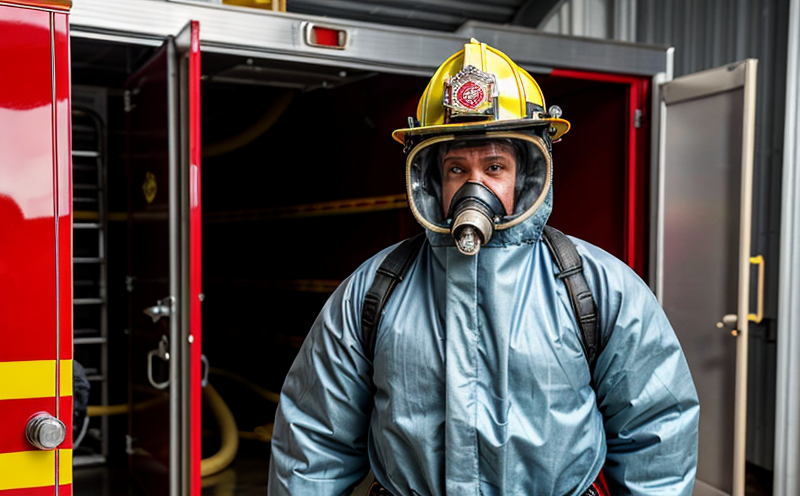Chemical Resistance Testing of Firefighter Gear
The chemical resistance testing of firefighter gear is a critical aspect of ensuring that firefighters are adequately protected against hazardous chemicals they may encounter in the line of duty. The primary objective of this test is to evaluate how effectively the protective clothing and equipment can withstand exposure to various chemicals without compromising its integrity or performance.
Firefighters often face numerous hazards, including flammable liquids, gases, and other potentially harmful substances. Ensuring that their gear remains intact under such conditions is paramount for protecting lives. This testing not only verifies the durability of the materials used in construction but also ensures compliance with international standards.
The process typically involves exposing samples of firefighter gear to a range of chemicals under controlled laboratory conditions. The tests assess factors like permeation rates, diffusion rates, and overall integrity maintenance over time. These tests can be performed on various components such as turnout coats, gloves, boots, helmets, and other protective gear.
For instance, when testing chemical resistance in turnout coats, the sample is placed into a container with a specified chemical for a set duration. The permeation rate is monitored using sensitive detection equipment to measure any penetration through the material. This helps determine if there would be any risk of chemicals entering the protective layer and coming into contact with the wearer.
The same principles apply to gloves, boots, helmets, and other personal protective equipment (PPE). Each component undergoes its own series of tests tailored to its specific function within the ensemble. For example, gloves might be tested for their ability to prevent chemical burns by assessing how quickly a chemical can penetrate through them.
Once the testing is complete, detailed reports are generated that document all findings including permeation rates, diffusion coefficients, and any other relevant metrics. Compliance with international standards such as NFPA 1971 (US National Fire Protection Association) or EN ISO 6583:2014 (European Norm) is a key factor in determining whether the gear passes the test.
These tests are essential not only for fire departments but also for manufacturers who produce firefighting equipment. By adhering to these rigorous standards, they can ensure that their products meet or exceed regulatory requirements and provide reliable protection against various chemical hazards faced by firefighters worldwide.
Applied Standards
The chemical resistance testing of firefighter gear is governed primarily by NFPA 1971, which specifies the performance criteria for protective clothing systems used by firefighters. Additionally, EN ISO 6583:2014 provides similar guidelines but focuses more on European standards.
NFPA 1971 sets forth strict requirements regarding the construction and performance of firefighter protective clothing. It mandates that fabrics used in these garments must possess certain properties such as flame resistance, thermal stability, and mechanical strength. The standard also includes provisions related to chemical resistance testing where permeation rates are measured after exposure to specific chemicals.
EN ISO 6583:2014 similarly outlines the necessary characteristics for protective clothing but with a focus on European markets. This standard covers various aspects including material selection, design considerations, and performance requirements such as chemical resistance.
To ensure compliance with these standards during testing, laboratories use specialized equipment capable of simulating real-world scenarios accurately. For example, permeation chambers allow for precise measurement of how quickly a given chemical can pass through the fabric under controlled conditions.
International Acceptance and Recognition
The results of chemical resistance testing are widely recognized internationally due to their stringent nature and rigorous methodology. Both NFPA 1971 and EN ISO 6583:2014 have gained widespread acceptance among fire departments, manufacturers, and regulatory bodies across different countries.
Many nations have adopted these standards either directly or through adaptation into national codes. This ensures that firefighters around the world receive comparable protection when wearing protective gear certified under these protocols.
For instance, in North America, NFPA 1971 is widely accepted not only by US fire departments but also those in Canada and other regions where English-speaking firefighters operate. Similarly, EN ISO 6583:2014 enjoys significant recognition within Europe and beyond.
International acceptance extends beyond mere compliance; it fosters a global understanding of the importance of chemical resistance testing in enhancing firefighter safety. This shared knowledge encourages continuous improvement in technology and materials used for producing protective gear, leading to better protection against evolving hazards faced by firefighters globally.
Use Cases and Application Examples
The application of chemical resistance testing in firefighter protective gear extends beyond just compliance with standards; it plays a crucial role in safeguarding the lives of firefighters. By ensuring that their equipment can withstand exposure to hazardous chemicals, fire departments enhance operational safety while minimizing risks associated with potential breaches.
One prominent use case involves scenarios where firefighters are required to enter areas contaminated by toxic substances such as gasoline or other flammable liquids. In these instances, chemical resistance testing ensures that the turnout coats and gloves used meet strict performance criteria, thereby reducing the risk of burns or absorption leading to severe health issues.
Another critical application pertains to structural firefighting where firefighters may encounter various chemicals during rescue operations or fire suppression activities. Properly tested gear minimizes exposure risks even when dealing with highly volatile compounds like hydrogen chloride or ammonia gas.
Besides these high-risk situations, chemical resistance testing also benefits routine training exercises conducted by fire departments. During mock drills simulating hazardous environments, firefighters can familiarize themselves with the behavior of their protective equipment under real-world conditions. This familiarity enhances confidence and readiness during actual emergencies.





